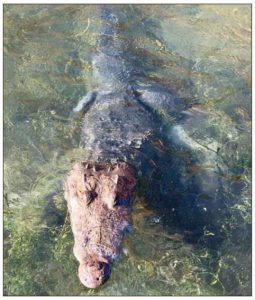The Dry Tortugas are a small, remote cluster of islands 70 miles west of Key West. This Dry Tortugas American Crocodile hasn’t seen another member of his own species since he swam out here in 2003 — which makes it difficult not to think of him as the World’s Loneliest Crocodile.
This American Crocodile has been on the island of Garden Key, in the Dry Tortugas for over a decade, 70 miles west of Key West in the middle of the ocean. He is being transferred due to the parks concern of him attacking guests. He will travel by seaplane to the Everglades. “The crocodile was released in the West Lake area of Everglades National Park and swam away on his own,” said Denese Canedo, a spokeswoman for Dry Tortugas and Everglades national parks.
When the American Crocodile is relocated they often return to their “home” fairly quickly. Post in the comments how long you think it will take this American Crocodile to return to the Dry Tortugas.
Here is some background on the Dry Tortugas Crocodile.
Park rangers began to notice a change six to eight months ago, when the croc started spending more time near the campground and swimming beach. Infrequent sightings that occurred once every couple of weeks two years ago jumped to a half dozen a day. Rangers reported anglers and visitors had increasingly started to feed the crocodile, which was gaining a social media following turning up in YouTube videos. So about six months ago, rangers started tracking its movements, similar to assessments done for aggressive bears in western parks, he said.
“We were starting to see a strong connection between people and food for the croc. It would start following people. When we start to see a change in behavior like that, it’s an indicator that the risk is a lot higher,” he said.
Then a week and a half ago, Simpson said an angler was spotted chumming waters near the croc, trying to draw it over. Cleatus made a beeline for the bait, which raised alarms, he said. On Friday, the park asked the U.S. Fish and Wildlife Service for permission to move the crocodile, said spokesman Ken Warren, which must approve any actions because of the croc’s threatened status.

to National Park Service rangers. v
Mark Parry, a wildlife biologist with the National Park Service, specializes in monitoring large reptiles, such as alligators and crocodiles. He catches Cleatus every few years with a crew of biologists and park staff members. The park staff catches Cleatus to do a “growth health assessment” on the crocodile, said Tracy Ziegler, who oversees science projects at the park.
“We haven’t captured him in quite a few years,” she said. “We’re trying to see whether or not he grows faster or slower in this environment.” “This environment” refers to a place without any fresh water. Crocodiles usually live in a mix of salt water and fresh water. The biologists have some baseline data from when they caught Cleatus once before, six years ago.
Parry approached the croc from behind. He quickly straddled the croc’s shoulders and sat on him. He pressed down on the snout until it closed, then kept it shut with one hand as he wrapped several loops of electrical tape around it. The crew then carried the crocodile onto the beach.
Parry put a knee on the croc’s neck, pulled out a yellow tape, and started measuring like a tailor. “We need head length, snout vent length dorsally, total length, tail girth, mass, sex…” he said. Getting all the measurements took about half an hour. Cleatus’ yellow eyes stared straight ahead the whole time.
The croc was just under 9 feet, and 155 pounds — about a foot longer than the last time they caught him six years ago. Parry said he seemed to be growing at a pretty normal rate. He could end up as long as 12 feet.
Source: Lonely crocodile Cleatus lives at Dry Tortugas National Park
